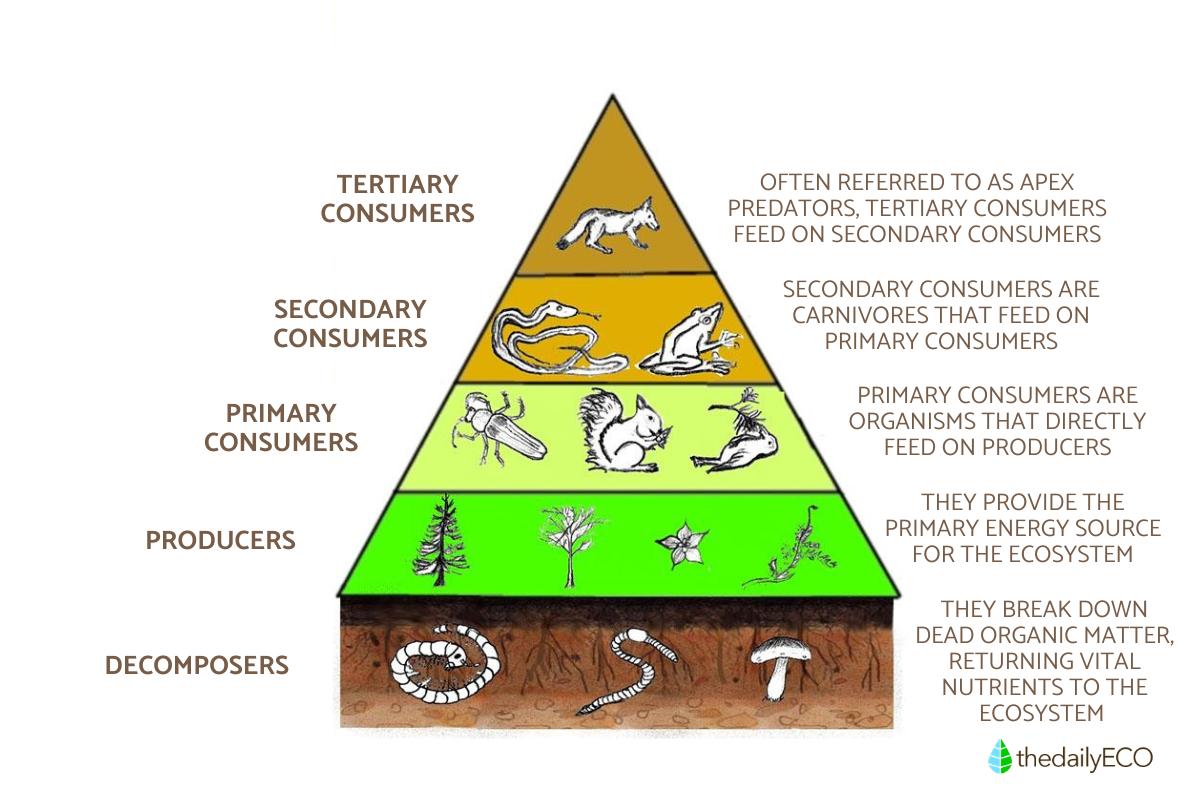What Are Ecological Pyramids?


Ecological pyramids are essential tools used in ecology to understand how energy, biomass, and organism numbers are distributed across different trophic levels in an ecosystem. These pyramids graphically represent the flow of energy from producers (like plants) to various levels of consumers and ultimately to decomposers. By illustrating the relationships among organisms, ecological pyramids help us visualize the transfer of energy and nutrients within ecosystems.
In this article bythedailyECO, we’ll explore what ecological pyramids are, their various types —energy, biomass, and numbers— and highlight their importance in maintaining ecosystem stability and health.
Understanding ecological pyramids in biology
Ecological pyramids are a key concept in ecology that illustrate how energy and matter flow through ecosystems. Typically represented as triangular structures, these pyramids display different trophic levels, with each level signifying a distinct group of organisms.
At the base of the pyramid are producers, primarily photosynthetic organisms like plants. These producers play a crucial role by converting sunlight into chemical energy through the process of photosynthesis. This stored energy, found in the form of organic matter, serves as the primary food source for various other organisms.
As we move up the pyramid, we encounter the consumers.
- The first tier consists of primary consumers, which are herbivores that feed directly on producers.
- Above them are the secondary consumers, or carnivores, that prey on the primary consumers.
- At the top level are the tertiary consumers, also known as apex predators, which primarily feed on secondary consumers.
- Additionally, the pyramid includes decomposers at its apex. These organisms break down dead organic matter, returning vital nutrients to the ecosystem and ensuring its sustainability.
The flow of energy through these trophic levels is governed by the laws of thermodynamics. According to these laws, energy cannot be created or destroyed; it can only be transformed from one form to another. As energy transfers from one trophic level to the next, a substantial portion is lost as heat, resulting in a decrease in available energy at higher levels. This energy inefficiency is what gives the pyramid its characteristic shape, highlighting the importance of each level in maintaining ecological balance.

Types of ecological pyramids in ecosystems
Ecological pyramids of numbers
The pyramid of numbers illustrates the number of individual organisms at each trophic level in an ecosystem. Typically, the base is wider, showing a larger population of producers, such as plants. As you move up the pyramid, the levels representing primary consumers, secondary consumers, and tertiary consumers become progressively smaller.
However, certain ecosystems can exhibit inverted pyramids, where the base is narrower and the top wider. This often happens in environments with old or established populations or in cases of parasitic relationships, where fewer large hosts support many parasites.
Ecological pyramids of numbers are easy to understand and visualize, but can be misleading in ecosystems with very large or very small organisms.
Ecological pyramids of biomass
The pyramid of biomass reflects the total mass of organisms at each trophic level, often measured in terms of grams or kilograms of carbon per unit area.
In most terrestrial ecosystems, the base is wider, representing the greater biomass of producers like plants and trees. However, in marine ecosystems, we sometimes see inverted pyramids because phytoplankton, the primary producers in the ocean, have very low biomass but reproduce and are consumed very rapidly by primary consumers like zooplankton.
It is important to note that pyramids of biomass account for the size of organisms but can be affected by seasonal fluctuations and differences in organism size.
Ecological pyramids of energy
The pyramid of energy shows how energy flows through an ecosystem. As energy transfers from one trophic level to the next, much of it is lost as heat due to metabolic processes. This energy loss results in progressively less energy available at higher trophic levels, leading to the classic pyramid shape.
The base is formed by producers, such as plants, which capture and convert solar energy into organic matter. Moving up, primary consumers, secondary consumers, and tertiary consumers occupy higher levels, but the amount of energy available to them decreases at each step.
Pyramids of energy, while the most accurate representation of energy transfer, are difficult to measure directly.

Factors affecting ecological pyramids
Ecological pyramids are shaped by several key factors that influence the distribution of organisms across different trophic levels. These factors can significantly impact the size, shape, and balance of the pyramid. Here’s a closer look at some of the most critical influences:
Primary productivity:
The primary productivity of an ecosystem refers to the rate at which producers, such as plants or phytoplankton, convert solar energy into organic matter through photosynthesis. Higher productivity means that more energy is available at the base of the ecological pyramid, leading to larger populations of producers. This, in turn, supports a greater number of consumers at higher trophic levels.
Ecosystems with higher productivity often have more robust pyramids, while ecosystems with lower productivity may show narrower pyramids due to limited energy availability.
Complexity of the food web:
The complexity of the food web also plays a significant role in shaping ecological pyramids. A simple food web with distinct food chains will often result in a clearly defined pyramid with distinct levels for producers, herbivores, and carnivores. However, in ecosystems with more complex food webs, where species may belong to multiple trophic levels or consume a variety of organisms, the pyramid may appear less regular. This complexity can blur the boundaries between trophic levels, leading to more intricate and less distinct pyramid shapes.
Habitat heterogeneity:
The diversity and variety of habitats within an ecosystem, known as habitat heterogeneity, can influence the distribution of species at each trophic level. In ecosystems with a wide range of microhabitats, the distribution of producers and consumers can vary, creating imbalances in certain areas of the ecological pyramid.
This may cause the pyramid to have irregular or uneven shapes, depending on how different species are distributed across habitats.
Seasonal variations:
Seasonal changes in temperature, precipitation, and food availability can cause fluctuations in species populations, which affects the shape of ecological pyramids. For example, during spring and summer, when food is more abundant, the base of the pyramid may expand as producers and primary consumers increase. In contrast, during the colder months, populations may decline, leading to a temporary contraction of the pyramid. This seasonal variability highlights the dynamic nature of ecosystem dynamics.
Human activities:
Human activities, such as pollution, habitat destruction, overfishing, and deforestation, have a profound impact on ecosystems and their energy transfer dynamics. For example, overfishing can drastically reduce populations of apex predators, shifting the balance of the pyramid and causing disproportionate increases in lower-level consumers. Pollution and habitat destruction can reduce biodiversity and disrupt natural food chains, which can alter the entire structure of the ecological pyramid.
For a closer look at how energy is stored and used within ecosystems, check out our in-depth exploration of natural energy systems.
If you want to read similar articles to What Are Ecological Pyramids?, we recommend you visit our Environmental education category.







